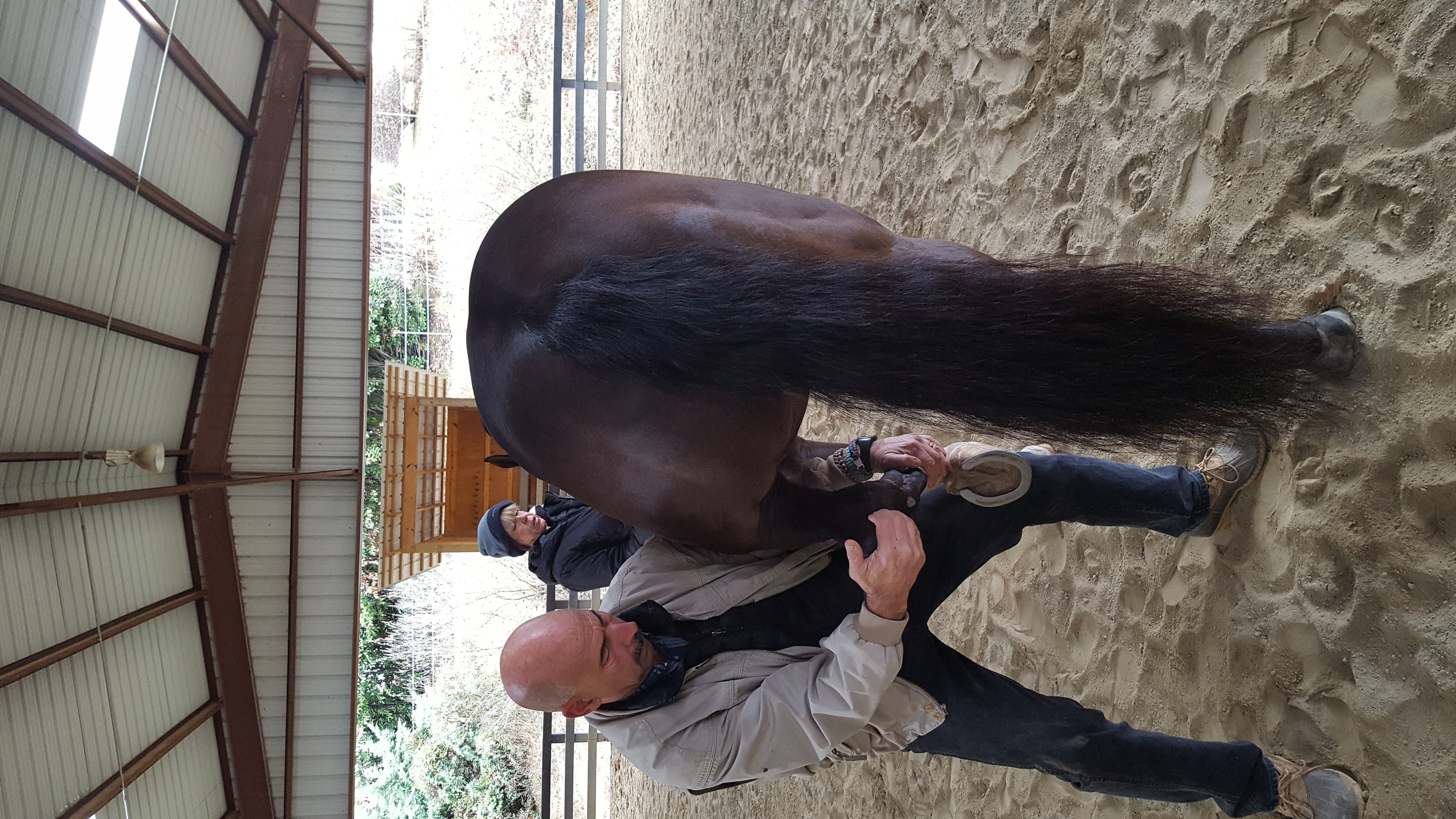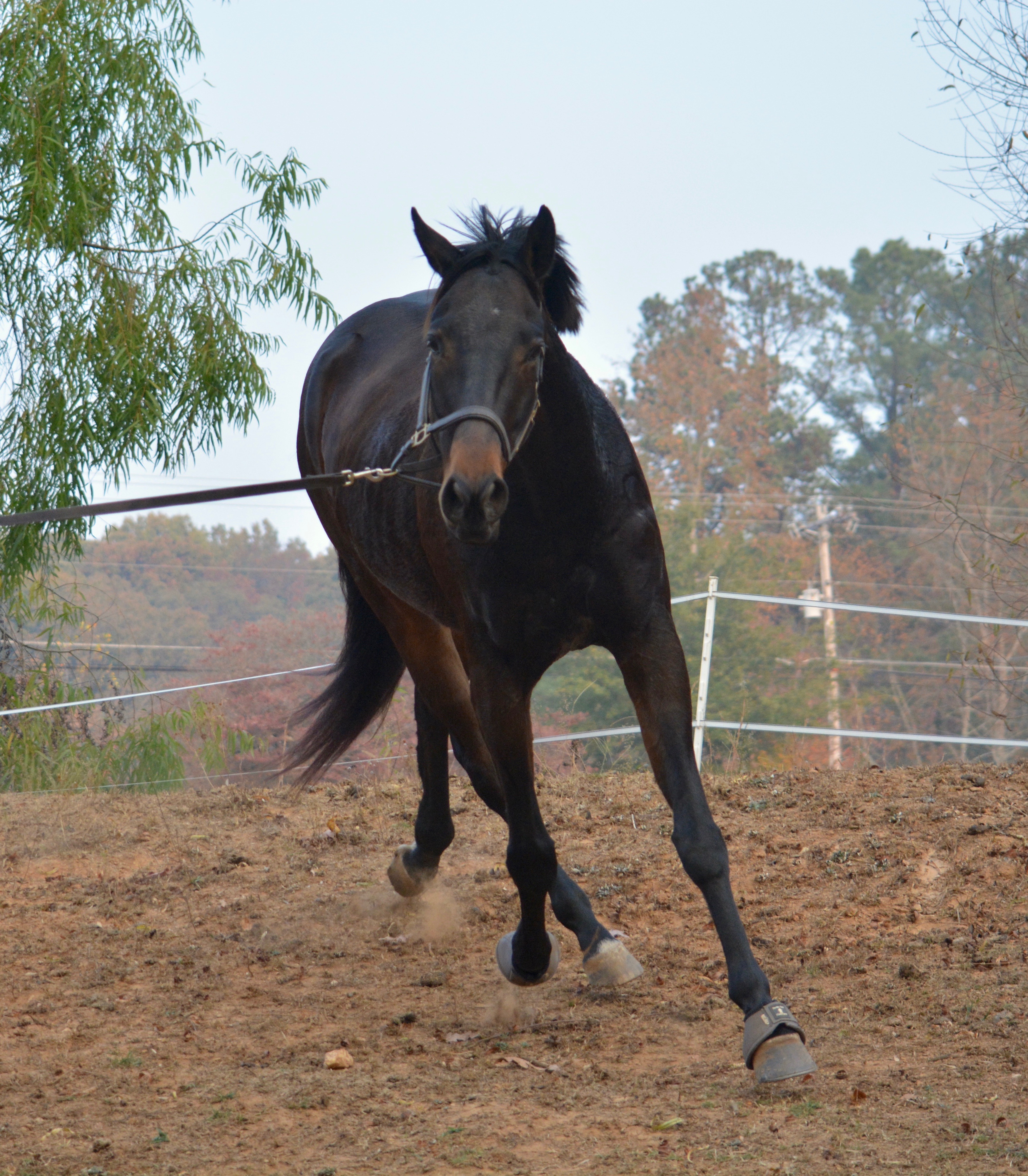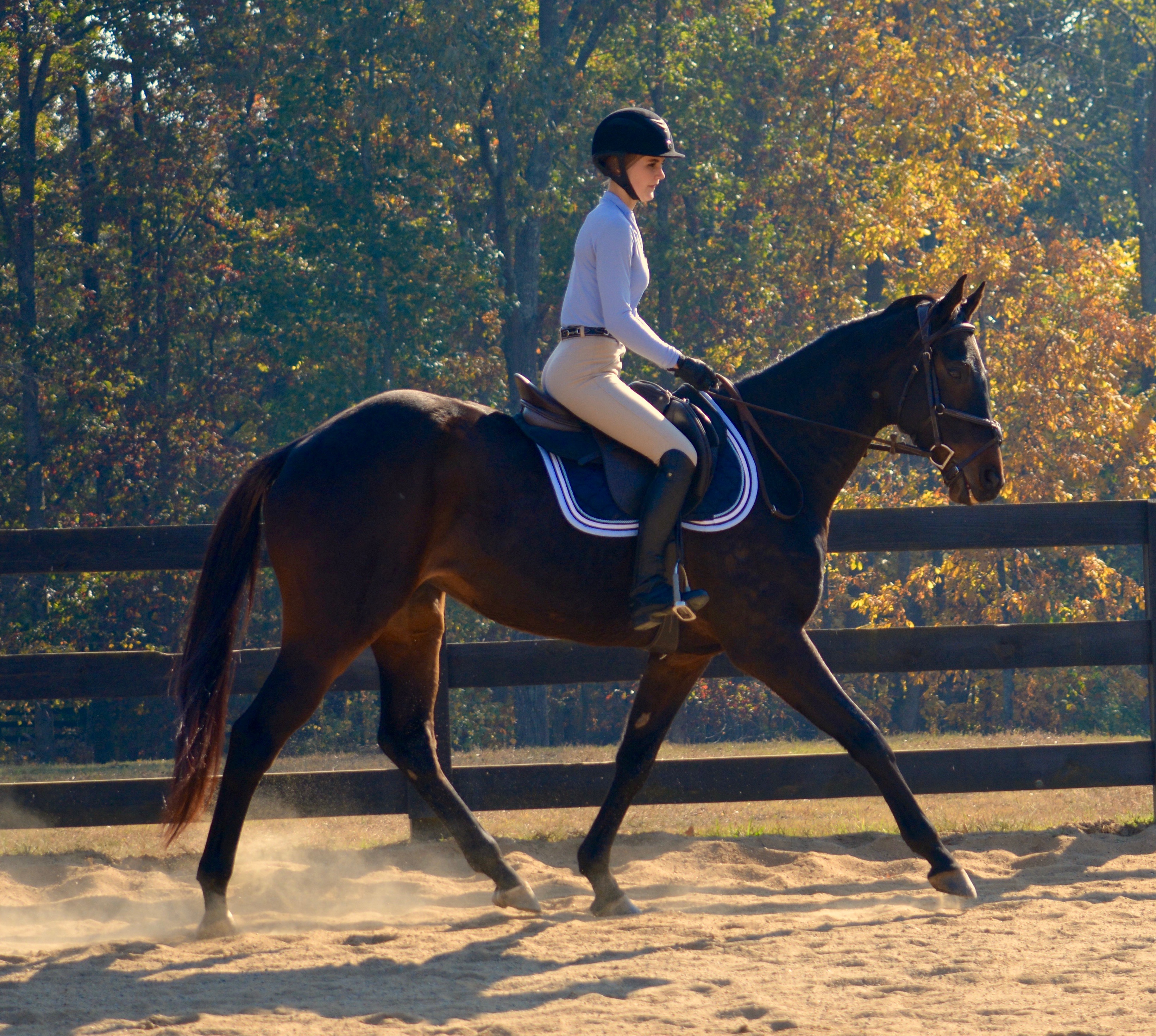
The equine stifle is similar, anatomically and physiologically, to the human knee but a bit more complex and generally more stable. Both joints use cruciate and patella ligaments, along with other stabilizing structures, to connect the bony framework that make up the joint: the tibia, fibula, femur and patella (knee cap). Horses, however, have much bigger quadriceps, the large muscles above the knee that make up the thigh, and three patella ligaments compared to only one in humans. These extra ligaments factor into the unique biomechanics that allow the horse to “lock” his knee cap and achieve a deep resting state while standing up, which was an important evolutionary advantage for a prey animal.
Even so, the stifle is susceptible to arthritis, resulting from a slow process of wear and tear occurring as a normal consequence of athletic activity, and/or more acute, traumatic soft-tissue strains and tears. Soft-tissue damage, such as cruciate-ligament tears and meniscal (fibrocartilage discs between the femur and tibia) injuries, are generally less common in horses than in humans because of the increased stability of the equine stifle. These types of problems, however, are serious and can end a horse’s athletic career.
Who’s At Risk
Injuries to the ligaments of the equine stifle generally result from a combination of speed and rotation: awkward takeoffs or landings from jumps, sudden stops, quick changes of direction and other missteps a horse may take when traveling at speed or when out of balance. In these instances, a horse’s attempt to unevenly load isolated parts of the stifle can overstress some of the joint’s stabilizing structures, causing injury. Dressage horses, who do not perform at speed like jumpers and eventers, may also be susceptible to stifle injuries because the requirements of their sport necessitate bending and rotating their upper bodies, which can also place the stifle joint at risk.
But it isn’t only equine athletes whose stifles are at risk of injury. Any “pasture potato” can incur a stifle injury from direct trauma, such as kicks, slips, falls or problems often associated with bad footing from wet, muddy or icy conditions. In fact, it is often these weaker, less fit and overweight horses who more commonly sustain stifle injuries. Inadequately developed abdominal and core muscling, along with a general lack of conditioning and tone, place these horses at greater risk. Poor foot care and imbalanced landing and loading can amplify the uneven forces on the body and potentially lead to stifle injuries as well.
Young horses are especially vulnerable during growth spurts (periods of rapid bone and body-mass development, characterized by uneven growth of different structures) as their ligaments often become either tighter or more lax depending on the changing bones and joint angles. Since the stifle joint consists of four bones and various ligaments, this area is frequently involved in growth-related problems. As a young horse’s stifle bones develop, it can take time for the slower growing ligaments to catch up and for the quadriceps muscle to also grow in size and strength.
During these periods, riders often comment that their previously problem-free horses now feel “weak behind” or “not connected.” These horses may stumble more frequently; they may fall out behind; and their stifle joints may even make popping or clicking noises. When going downhill, riders on these growing youngsters may experience a general unwillingness and inability to maintain a straight line (the horse will try to proceed downhill at an angle) and even intermittent near-collapse in severe cases. Although these symptoms occasionally indicate structural problems, they are most often signs of weakness.
Turnout and Stretching
Careful progressive strengthening work can help protect your horse’s stifles against injury, especially if that area is already weaker due to conformation, lack of conditioning or other factors. If he is obviously lame or if a joint is swollen, tender and/or painful, then seek veterinary attention to rule out any medical causes before starting a strengthening program. Once you are sure he is capable of tolerating a fitness program, however, then the more you sensibly condition him, the fewer injuries he will likely experience. This is especially true for the stifle joint. Here are two general ways to strengthen it:
1. Increase overall daily movement. Give your horse as much turnout as possible, ideally on pasture with rolling hills and with tractable companions (horses tend to be more active when pastured in the company of others). If you are feeding hay, spread it out in multiple piles so your horse has to be more active in his eating behavior.
2. Perform stretching exercises. Always remember your personal safety and that of your horse as you attempt these exercises. They are best done in a flat area with good footing and it is usually necessary, especially initially, to have a helper hold your haltered horse with a loose but controlled lead. In each of the following exercises, lift your horse’s hind foot off the ground and stretch as described until you feel slight resistance. Hold the stretch for 10 to 20 seconds as tolerated, then release. As he becomes more accustomed to and comfortable with a stretching routine, you will be able to work on gradually improving his range of motion.
- Flex the hip and stifle by lifting your horse’s hoof upward and pushing it inward toward the midline of the body. (This is similar to the motion veterinarians use to do a hock flexion test as part of a lameness or prepurchase examination.) Then, with the hoof still lifted and the hock flexed, pull the leg outward away from your horse’s body.
- Pull the hind hoof forward toward the back of the knee of the front leg on the same side.
- Pull the hoof backward, stretching out the hind leg in the same position you would use to pick out the foot or that a farrier would use to trim it. Slow pressure and your horse’s relaxation will eventually allow you a good deal of extension in this position.
Another great way to begin getting your horse to stretch and use his stifles is with a good-quality working walk, which requires him to be balanced on each leg and to use his quadriceps to push forward. This, in turn, strengthens muscles and ligaments. Ask a dressage instructor or other equine professional to show you how to get your horse properly rounded in his frame and correctly stepping his hind legs up underneath his body. Understand that this may take some time as a weak horse will have difficulty achieving a proper frame. Consistent, correct slow work will pay dividends over time, however.
Stretching


Strengthening Work
A third way to strengthen the stifle is from exercises you do on the ground and in the saddle.
Unmounted
- With your haltered horse held by a helper, stand a few feet off, perpendicular to his hip, and grasp his tail. Gently pull it toward you until you feel your horse resist the pressure and pull back. You will notice his back, abdominal muscles and, importantly, his quadriceps muscles tighten as he braces against your pull. Hold pressure for 10 to 20 seconds and release. Repeat this exercise 10 times on each side.
- Hand-walk your horse up and down slight inclines. Ask him to walk slowly and maintain a straight line, not allowing him to cheat and swing his haunches to either side. This requires balanced use of the stifles. Periodically halt your horse—this increases the forces on the front part of the quadriceps and patella ligaments—and then walk off again. Doing this exercise unmounted is especially valuable because the horse can focus on his own balance and movement without trying to compensate for the rider’s weight and position. As with all attempts at strength and conditioning work, an improperly done exercise is nearly worthless and often damaging, so keep the exercises simple—and do simple well.


Mounted
- Concentrate on transitions—walk to trot, trot to canter, walk to canter, and so forth. Always aim to make them smooth and balanced as this builds muscle, tightens ligaments and produces better motion.
- When riding or doing conditioning work in open pasture or fields, instead of traveling in long, straight lines, make shallow serpentines that require your horse to bend and to use the inside and outside leg muscles—principally the quadriceps.
- If you have access to deep sand, such as beaches or other soft surfaces, practice riding in it. Strenuous work on surfaces like these can cause other injuries if you do too much too soon. So pay close attention to my advice that follows about building up gradually. As your horse’s strength improves, concentrate on motions that also principally use the medial and lateral quadriceps muscles, like circles and spirals.

Riders have a tendency to overdo strength training at first—and to give up on it too early. Whatever exercises you decide to do, it is very important to progress slowly and in a step-by-step manner. Commit to a long-term program, start with short, easy sessions and never increase both intensity and duration of exercise at the same time.
For example, if you start with 15 minutes of longeing on flat ground—including warm-up, cool down and multiple changes of direction—repeat the same program in your next session. If your horse does that easily, then add three to five minutes in the next session. Continue gradually increasing the duration for seven to 10 sessions until your workout time is 30 minutes or longer. Then you can reduce the duration of time for a particular session and add some hill work (increase intensity)—doing, for example, 10 minutes of flat longeing and eight minutes of walking up and down hills. If, at any point, your horse seems to be struggling with a workout, you can always simply go back to the lower-level intensity session that you had previously been doing easily and stay there for a while longer before trying to increase intensity again.
Mix these strength-training sessions into your regular training routine, which should involve a minimum of three days of exercise per week but preferably four or five. Wear a watch and time each session and avoid overworking, especially when a session is going really well. Keep a record of your program and monitor intensity and duration. This will help you chart progress and decide when to push the conditioning and when to back off and allow your horse a bit of training rest—both of which are important when trying to achieve better fitness.
With methodical training, patience and attention to exercises that target the specific muscles and ligaments involved, you can help strengthen your horse’s stifles and assure him a happier, healthier athletic career.
Dr. Kenneth L. Marcella is a graduate of the New York State College of Veterinary Medicine at Cornell University. For more than 30 years he has treated sporthorses of all disciplines and levels, including international competitors. Dr. Marcella has served as a veterinary official at many events around the world, including national championships, World Equestrian Games and Olympic competitions. He is board-certified in thermal imaging and is currently serving on the selection committee for the United States Endurance Team.
With an undergraduate degree in English from Dartmouth College, Dr. Marcella has also written articles for numerous publications, including Dressage Today, DVM 360, Endurance News, The American Quarter Horse Journal, and the Thoroughbred Times. In his free time, he plays and coaches hockey.
This article was originally published in the April 2017 issue of Practical Horseman.










